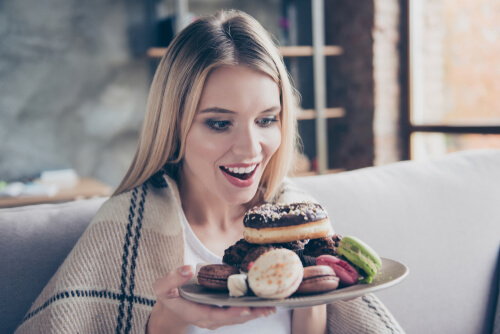How to Tell the Difference Between Real and Emotional Hunger


Written and verified by the psychologist Elena Sanz
You’ve undoubtedly heard of emotional eating. In fact, perhaps you’ve even occasionally been told that “You’re not hungry, you’re just bored”. If you find yourself identifying with this kind of situation, you’ll know that it can often be overwhelming. Therefore, in this article, we’re going to tell you how to differentiate between real and emotional hunger.
Emotional hunger means you use food to regulate your mood. In other words, its intake loses its original meaning, that of nourishing yourself with the elements you need for your physical performance.
It’s normal to often find yourself overwhelmed by feelings of sadness, anger, frustration, or disappointment. Furthermore, if you don’t have the personal tools and resources to deal with them, it’s easy and tempting to turn to food to ease your discomfort.
You must remember that, by consuming certain types of food, you activate your brain’s reward circuit. This gives you pleasant sensations.
However, this well-being is only temporary. Indeed, sooner rather than later, your latent problem resurfaces. Nevertheless, on this occasion, it’s also accompanied by feelings of guilt for having eaten more than necessary. Therefore, to stop the cycle of emotional eating, you must be able to recognize it and act accordingly.

How to tell the difference between real and emotional hunger
Next, we’re going to explore some differentiating characteristics of real hunger and emotional hunger. These will help you identify if you’re facing one or the other.
Real hunger
- It emerges gradually and increases over time.
- Real hunger originates in your stomach as it’s a physiological sensation.
- You’re aware of what you’re going to eat. You control it and plan it. You have the ability to select what type of food you want to consume at the time.
- Generally, you opt for nutritious foods and healthy and balanced dishes that satisfy your appetite.
Emotional hunger
- It appears suddenly and abruptly. In fact, you experience a sudden craving for food that you need immediately.
- It doesn’t originate in your stomach, because it’s not a physiological sensation. It has its origin in your mind as a result of certain images or mental representations of food. In addition, when you’re thinking or imagining a type of food, the impulse to eat it becomes so strong that you lose control.
- Your diet becomes chaotic. You eat in an automatic and uncontrolled manner, without measuring quantities or deliberately selecting foods. You eat on impulse, out of necessity, in large quantities, and without making a deliberate choice.
- As a rule, you consume hypercaloric and ultra-processed foods that are high in fats and sugars and with little nutritional value. These foods, in addition to being harmful, don’t fill you up or only do so for extremely short periods of time.

How can you avoid emotional eating?
As you can see, the differences between both concepts are clear and evident. If you pay attention to the signs, it’ll be easy for you to understand what kind of hunger you’re dealing with. However, what can you do once you recognize you’re suffering from emotional hunger?
First of all, stay alert. When you feel hungry, stop and try to identify what type it is, in accordance with the above guidelines.
Next, write down what situations or emotions arouse emotional hunger in you. For example, you might resort to this type of diet to calm feelings of anxiety. Or, you may use it to stop experiencing feelings of sadness or emptiness.
Once you’ve identified your triggering emotions, you need to develop healthier coping strategies. You could use meditation, diaphragmatic breathing, or therapeutic writing. In fact, any option that helps you process this uncomfortable emotional state will be useful.
You need to give food its proper function back. Remind yourself that food is fuel for your body and not a shortcut for your mind to use so you don’t have to face your pain.
In order to do this, you must make a firm decision to unlink the idea of food from your emotional states. When you feel that your emotional balance is compromised, carry out a more useful and healthy alternative. Of course, if the situation gets too much for you, you can always turn to a professional.
All cited sources were thoroughly reviewed by our team to ensure their quality, reliability, currency, and validity. The bibliography of this article was considered reliable and of academic or scientific accuracy.
- Menéndez, I. (2007). Alimentación emocional. DeBolsillo.
- DRESSL, N. L., ETCHEVEST, L. I., FERREIRO, M., & TORRESANI, M. E. (2018). CORTISOL COMO BIOMARCADOR DE ESTRÉS, HAMBRE EMOCIONAL Y ESTADO NUTRICIONAL. Revista Nutrición Investiga. Volúmen, 3(1).
This text is provided for informational purposes only and does not replace consultation with a professional. If in doubt, consult your specialist.








